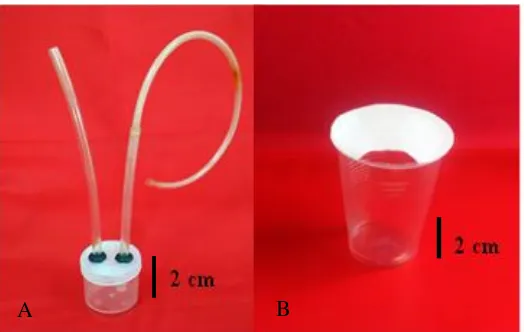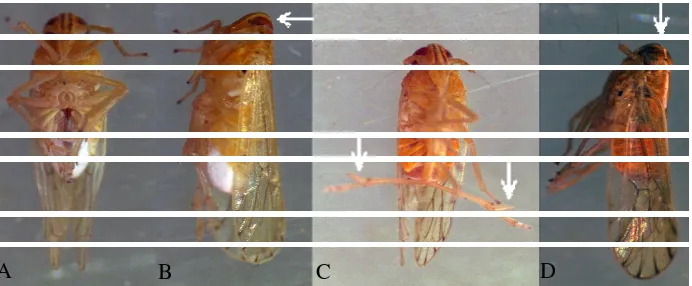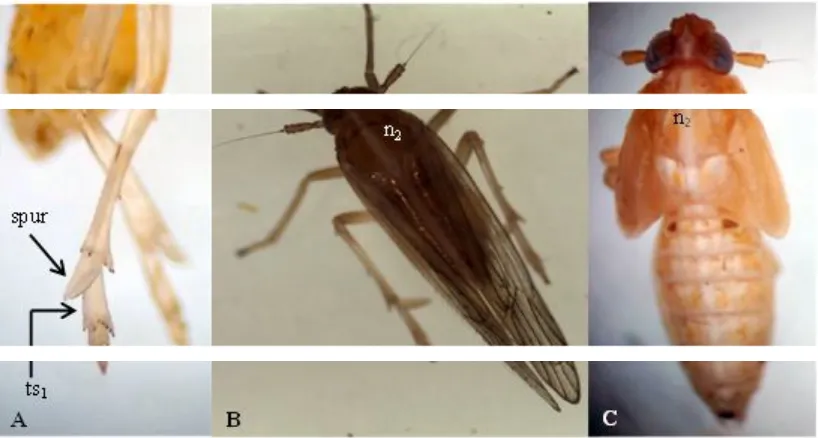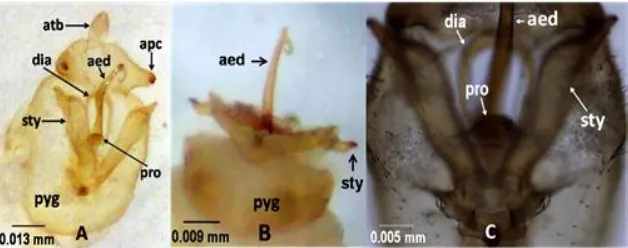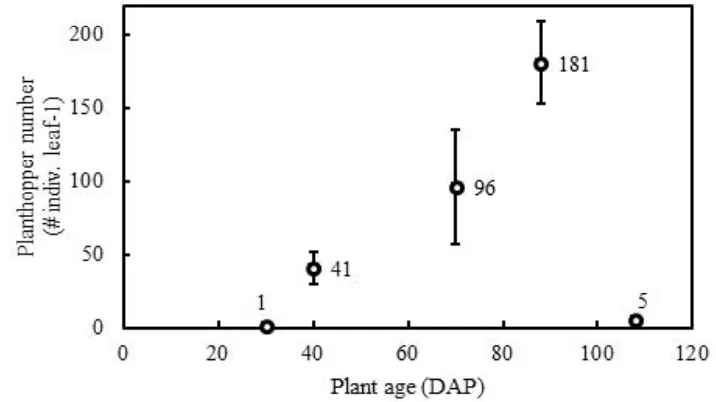THE WHITE-BELLIED PLANTHOPPER (HEMIPTERA: DELPHACIDAE)
INFESTING CORN PLANTS IN SOUTH LAMPUNG INDONESIA
Franciscus Xaverius Susilo1, I Gede Swibawa1, Indriyati1, Agus Muhammad Hariri1, Purnomo1,
Rosma Hasibuan1, Lestari Wibowo1, Radix Suharjo1, Yuyun Fitriana1, Suskandini Ratih Dirmawati1,
Solikhin1, Sumardiyono2, Ruruh Anjar Rwandini2, Dad Resiworo Sembodo1, & Suputa3
1Fakultas Pertanian Universitas Lampung (FP-UNILA)
Jl. Prof. Dr. Sumantri Brojonegoro No 1, Bandar Lampung 35145
2UPTD Balai Proteksi Tanaman Pangan dan Hortikultura Provinsi Lampung
Jl. H. Zainal Abidin Pagaralam No. 1D, Bandarlampung 35132
3Fakultas Pertanian Universitas Gadjah Mada
Bulaksumur, Yogyakarta 55281
ABSTRACT
The White-Bellied Planthopper (Hemiptera: Delphacidae) Infesting Corn Plants in South Lampung, Indonesia. Corn
plants in South Lampung were infested by newly-found delphacid planthoppers. The planthopper specimens were collected from heavily-infested corn fields in Natar area, South Lampung. We identified the specimens as the white-bellied planthopper Stenocranus pacificus Kirkaldy (Hemiptera: Delphacidae), and reported their field population abundance.
Key words: corn white-bellied planthopper, Lampung, Indonesia, Stenocranus pacificus.
ABSTRAK
Wereng Perut Putih (Hemiptera: Delphacidae) Menginfestasi Pertanaman Jagung di Lampung Selatan. Sejenis wereng
ditemukan menginfestasi pertanaman jagung di Lampung Selatan, Lampung. Hama ini diidentifikasi sebagai wereng perut putih jagung, Stenocranus pacificus Kirkaldy (Hemiptera: Delphacidae). Infestasi masif hama ini terjadi pada pertanaman jagung di kawasan Natar, Lampung Selatan.
Kata kunci: wereng perut putih jagung, Lampung, Indonesia, Stenocranus pacificus.
INTRODUCTION
Corn plants are susceptible to the attacks of planthoppers. The commonly known planthoppers infesting corn plants in Indonesia are Peregrinus maidis
(Kalshoven, 1981). Peregrinus infestation varies in time and place but rarely reached an epizootic level. Other planthoppers, Nilaparvata sp., have also been known to associate with corn plants (Susilo & Swibawa, 2002). In November 2016, heavy planthopper attacks occurred in some farmer’s corn fields in South Lampung District. Were these the infestations of Peregrinus, Nilaparvata, or other kind(s) of planthoppers?
Are the planthoppers attacking corn plants in Sout h Lampung the white-backed planthopper
Sogatella? The first specimens of the corn planthoppers were available at FP-UNILA’s Department of Plant Protection Clinic. The specimens were originated from UPTD-BPTPH-Lampung Province that have been collected on 25th November 2016 and 19th December
2016, respectively, from the heavily infested farmer corn fields at South Lampung. Upon quick inspection, we noted general appearance of light brown notum and tergum with a median longitudinal pale stripe in each of the specimens and thought of them as the white-backed planthopper. However, that did not match with the black mesonotum and black tergum characters of the white-backed planthopper Sogatella furcifera Horvath as described in Kalshoven (1981). Therefore, there was a need for more detailed inspection in order to identify the specimens more accurately.
The objectives of this study were 1) to collect and identify specimens of delphacid planthoppers infesting corn plants in South Lampung and 2) to document the dynamics their field abundance.
MATERIALS AND METHOD
Study Site. The planthoppers were observed on corn fields in Natar area, South Lampung. The site is located + 15 km north-east of Bandarlampung City, Lampung, Indonesia. The observation consisted of two activities, ie. collecting the planthopper adult specimens and recording their field abundance. Both activities were done on 18th March 2017 and 25th March 2017.
Adult planthoppers (macropters) were field-collected using a cup trap or aspirator (Figure 1). The cup trap consisted of a disposable mineral water cup (top dia. = 6.5 cm, bottom dia. = 4 cm, height = 9.5 cm) while the aspirator consisted of a 4.5 cm dia. x 5.2 cm high plastic jar equipped with two plastic hoses (long = 50 cm, short = 20 cm) of 0.5 cm dia. each. The catches in the aspirator or cup were flushed with mineral water, picked up using a small brush, and gathered into a glass vial containing 70% ethanol solution. The vials were then brought to FP-UNILA’s Laboratory of Arthropod Pests for later handling, general morphology observation, and specimen identification.
The male specimens were used for identification. Their abdominal tagmata were cut and cleared overnight in 10% KOH solution. The cleared abdomens were then transferred to glycerin drop on an object glass for observation and identification. An insect pin was used to gently tease the last abdominal segment to expose its genital structures. Specimen identification and morphology documentation were done under a dissecting stereo-microscope (LEICA EZ4HD) using Wilson
(2005), Asche & Wilson (1990), Kumaresan et al. (2016), and Dupo & Barrion (2009).
The planthopper population abundance was recorded by direct counting. Five farmer fields were observed, ie. two fields on 18th March 2017 (size: 0.15 and 0.75 ha; age: 88 and 108 days after planting, DAP) and three fields on 25th March 2017 (size: 0.5, 0.5, and 0.75 ha; age: 30, 40, and 70 DAP). The first two fields were observed by systematic sampling of 4 rows field-1 and 5 plants row-1 while the last three fields by random sampling of 5 rows field-1 and 5 plants row-1. In each sampled plant, one leaf with maximum number of planthoppers was selected for the counting. The number of all planthopper stages (adults and nymphs combined) on the sampled leaf was tallied directly using a hand-tally counter.
RESULTS AND DISCUSSION
The corn plants in Natar area, South Lampung, were generally heavily attacked by the delphacid planthoppers (Figure 2A-E). Hybrid corn cultivars including P27 and BIOSEED 54 were grown in the area. The planthopper attack was initiated by appearance of white-cottony wax trenches or mass on the abaxial sides of the corn leaves (Figure 2A-B). Then planthopper colonies emerged on the leaves, as in Figure 2C that shows abundant nymphs, exuviae, and female brachypters. The planthopper massive attacks resulted in hopperburn plants (Figure 2D-E).
Figure 3 shows part of a corn leaf after removal of the white-cottony wax trench. The wax is a kind of covering mass secreted by the female planthopper to protect her eggs that she laid by insertion into the corn leaf tissue in patterned spots (Figure 3).
Figure 1. Aspirator (A) and cup trap (B) for collecting adult planthoppers.
Figure 2. General phenology of the planthopper attacks on corn plants. Deposition of white-cottony wax trenches along edges of the leaf vein (A) or smudges at theleaf base (B) indicating oviposition sites, emergence of the planthopper colony (C), and appearance of hopperburn symptom without (D) or with sooty-mold growths (E), in that order.
Figure 4. Macropters of the planthoppers attacking corn plants. Female ventralview (A), female lateral view (B), male ventral view (C), male lateral view (D). Female with white-colored abdomen (A, B), male with orange abdomen (C, D). Note conspicuous tibial spurs on hind legs (arrow, C). Also note rounded, less acute angled vertex-frons transition (arrow, B, D).
Planthopper Identification. Observation on the collected female and male macropters (Figure 4) shows that the female cathes were more prominent. Female abdomen was white-colored while that of male was
orange. Female body size was bigger than male (length as measured from the tip of vertex-frons turn to the tip of wings = 4.93+ 0.03 mm for female versus 4.20 + 0.04 mm for male, t-value = 14.39**, p-value = 0.000,
A B C D
A B C D E
Figure 3. Oviposition spots (openings) of the planthoppers in a corn leaf as seen under a LEICA EZ4HD microscope.Two rows of zigzaged spots along an edge of leaf vein after removal of the white-cottony wax cover.
calculated from nmale = nfemale = n = 30). That made the female more conspicuous than male. Between the two sexes, female was also more frequently encountered in the field (55.2% female, z-value = 3.54**, p-value = 0.0002, n = 1150). As afore-mentioned, female was the one responsible for secreting the white-cottony wax mass covering her ovipositing spots on corn leaves and this white mass indicated the start of their presence or attacks on corn plants (Figure 2A-B). The white-coloration of female abdomen should have to do with the secretion and deposition of this white mass that indicates the presence of the species on the corn plants. After this remarkable female, we propose a common name for our specimens as the corn white-bellied planthopper
(CWBPH).
To start identification, twelve delphacid genera (Wilson, 2005) were selected as the candidate genera for our planthopper specimens. The delphacid genera sensu Wilson (2005) are (in alphabetical order)
Caenodelphax, Eoeurysa, Javesella, Harmalia, Laodelphax, Nilaparvata, Peregrinus, Perkinsiella, Saccharosydne, Sogatella, Tagosodes, and Toya. Nilaparvata are characterized by the presence of lateral spines on the first tarsi of their hind legs. The next eight genera (Saccharosydne, Caenodelphax, Eoeurysa,
Peregrinus, Javesella, Harmalia, Laodelphax, and
Toya) have a common character, that is no median longitudinal pale stripes on their mesonota. Sogatella are characterized by U-shape pygofer diaphragm margin
while the key character of Perkinsiella is their frons with median carina forked near ventral aspect of eyes.
Identification was then worked through by selecting one genus out of the twelve based on the Wilson’s key characters (Wilson, 2005). Genera whose key character did not match with that of our specimens (Figure 5-7) were eliminated. In addition to having hind tibia with a large apical movable spur or calcar (spur, Figure 5 A, see also Figure 4 C) which confirms their inclusion in the Delphacidae, our specimens have other key morphological characters. Their hind first tarsal segments are each without lateral spines (Figure 5 A) which eliminates Nilaparvata as the candidate genus for our specimens. The mesonota of our specimens are light brown with median longitudinal pale stripe (Figure 5 B-C, Figure 7 B) which eliminates Saccharosydne,
Caenodelphax, Eoeurysa, Peregrinus, Javesella,
Harmalia, Laodelphax, and Toya. The pygofer diaphragm margins of our specimens are not U-shape (Figure 6 A, 6 C, eliminating Sogatella). Our specimens have median carinae forked at the dorsal aspect of eyes (Figure 7 A-B, eliminating Perkinsiella). That forking of median carina is the key character for Tagosodes
(Wilson, 2005).
There are some other genera of delphacid planthoppers, ie. the Sogatella groups sensu Asche & Wilson (1990) that need to be considered or eliminated in the process of generic designation for our specimens. This group includes Sogatellana, Latistria, Matutinus,
Figure 6. Pygofer (pyg) and male genitalia of the planthoppers attacking corn plants. A and C = ventro-caudal view, B = ventral view. Anal tube (atb), anal process (apc), paramere or style (sty), diaphragm (dia), protusion on the diaphragm (pro), and aedeagus (aed). Note the diaphragmal protrusion (pro, C) which is not sinuate and not U-shape. Note also the shaft-like aedeagus (aed, A-C) with a ring-like sub-apical hook (A, B).
Figure 7. Median carinae of the planthoppers attacking corn plants. Ventral view (A) and dorsal view (B). Longitudinal pale or white stripe indicated the median carinae. The median carina not forked at the ventral aspect (frons, yellow arrow, A) but forked at the dorsal aspect (vertex, red arrow, B). Note also median longitudinal pale or white stripe at the brown or light-brown mesonotum and metanotum (B).
and Tagosodes (Asche & Wilson, 1990). Sogatellana is characterized by two pairs of anal processes while our specimens by only one pair (apc, Figure 6 A). Mediodorsal pygofer diaphragm of Latistria is with sinuate protrusion; in contrast, the protrusion on the pygofer diaphragms of our specimens is not sinuate (pro, Figure 6A, 6 C). The head of Matutinusis is with acute transition angle of vertex to frons. In our specimens, the transition of vertex to frons is rounded and less acute-angled (Figure 4 B, D). Consequently, the choice of generic designation for our specimens was, once again, narrowed down to Tagosodes.
However, we could not designate our specimens to Tagosodes sensu Wilson (2005) or Asche & Wilson (1990) because their Tagosodes male genitalia did not match with those of our specimens. Our specimens are
each characterized by a unique aedeagus (aed, Figure 6 A-B). The aedeagus is 1) long and shaft like, 2) with a ring-like sub-apical hook, and 3) without spines (aed, Figure 6 A-B). The aedeagus of Tagosodes or the other delphacid genera, in contrast, are mostly compressed, twisted, and/or ornamented with various patterns of spines or teeth (Wilson, 2005; Asche & Wilson, 1990).
It is true that some delphacid planthoppers each also has shaft-like aedeagus but conspicuously differs from the aedeagus of our specimens. A species of
row of spines and the hook is straight (not ring-like). A species of Sogatellana is also known to have a shaft-like aedeagus (Asche & Wilson, 1990); however, this aedeagus is short and ornamented with a sub-apical clump of minute spines. In sum, no known species of delphacid planthoppers so far in the Nearctic or Palearctic regions has aedeagus as is in our specimens.
We then compared the aedeagus of our specimens with that of Asian species. Among the 65 species of 31 genera of Asian delphacid planthoppers (Dupo & Barrion, 2009), therein exists one species named Stenocranus pacificus Kirkaldy whose aedeagus (Plate 37f in Dupo & Barrion, 2009) is similar to (or of the same form as) that of our specimens (aed, Figure 6 A-B). Therefore, we identified the scientific name of our specimens as
Stenocranus pacifi cus Kir kaldy (Hemipt era: Delphacidae). To indicate the host plant, we also use the corn S. paci ficus as another name for our specimens. That way, the corn S. pacificus and the corn white-bellied planthopper (CWBPH) could be used interchangeably. pacificus body size of 4.0 – 6.3 mm (Dupo & Barrion, 2009; species features). In their identification key, however, Dupo & Barrion (2009) attributed another, albeit larger, body size interval of 6.8 – 7.8 mm to the rice S. pacificus. So far, the population of S. pacificus
sensu Dupo & Barrion (2009) with larger body size has not been found attacking corn plants in Lampung.
The number of calcar spines and the vertex-frons morphology of the corn S. pacificus also a bit deviate from those of S. pacificus sensu Dupo & Barrion (2009). Dupo & Barrion (2009) characterized the hind tibiae of
S. pacificus as each having 24-25 calcar spines. Our specimens each has 26-27 calcar spines (n = 20). S. pacificus sensu Dupo & Barrion (2009) is also with noticeably narrowed or produced head in front of eyes (Dupo & Barrion, 2009). In contrast, the heads of our planthopper specimens are not narrowed in front eyes. It is difficult to conclude at the moment whether these deviances are merely statistical or true morphological differences that are consistent and unique to the population of the corn S. pacificus.
S. pacificus might be exotic species for Indonesia and has been reported to attack other plants in the Poaceae family. Dupo & Barrion (2009) mentioned that in addition to attacking rice plants, S. pacificus could also attack sugarcane and grasses and they were
distributed across Philippines, Western Caroline Island, Palau, and Fiji. Wilson (2009) reported that S. pacificus
was native of Viti Levu Island, Fiji. Recently, the infestation of S. pacificus has been very massive on corn plants that were grown continuously in Natar area, South Lampung District, Sumatra-Indonesia.
Planthopper Field Abundance. The trend of S. pacificus or CWBPH abundance in Natar area was illustrated in Figure 8. At 30 DAP, only a few individuals were present on corn plants. About half population of the corn plants of this age was still free from the planthopper attacks while the other half was attacked by 1 or 2 macropter individuals leaf-1. The sign of white-cottony wax deposition was rarely found at this age. At 40 DAP, however, the white wax trenches and smudges (as in Figure 2 A-B) were prominent. At this plant age, the abundance of combined planthopper stages (nymphs + brachypters or macropters) increased multiplicatively than before with nymphs (and brachypters combined) being 4 times more abundant than macropters. The planthopper total abundance at 70 DAP was about double than that at 40 DAP and the total abundance at 88 DAP was also about double than that at 70 DAP. The condition and appearance of the corn plants at 70 DAP or 88 DAP, however, were similar to those at 40 DAP (as in Figure 2 C). The hopperburn symptom (as in Figure 2 D-E) started being detected at 88 DAP and massively evident at 108 DAP. At 108 DAP, the planthopper abundance dropped drastically to a very low level.
The abundance of CWBPH on corn plants peaked at 88 DAP (averaged 118 + 28 individuals leaf-1, Figure 8). With a leaf number average of 11 + 1 plant-1 (calculated from n = 110 plants), the planthopper abundance could reach 1,298 individuals corn plant-1 which was comparable with (or higher than) the brown planthopper (BPH) highest abundance on rice paddy (> 500 individuals hill-1; Mochida & Okada, 1979).
REFERENCES
Asche M & Wilson MR. 1990. The delphacid genus
Sogatella and related groups: a revision with special reference to rice-associated species (Homoptera : Fulgoroidea ). Systematic Entomology 15: 1 - 42.
Figure 8. Mean abundance of the planthoppers attacking corn plants in Natar area, South Lampung. DAP = days after planting. Bars = standard errors of the means (n = 20 plants for observation on 88 DAP and 108 DAP; n = 25 plants for observation on 30 DAP, 40 DAP, and 70 DAP).
be tested by routine observations, including weekly recording of the planthopper abundance on the corn fields.
CONCLUSION
We identified the planthoppers that attacked corn plants in Natar area, South Lampung, as Stenocranus pacificus Kirkaldy (Hemiptera: Delphacidae). We proposed their common name as the corn white-bellied planthoppper (CWBPH) after the unique character and ecological importance of their female abdomens. The key morphological characters of the planthopper specimens are as follow. (1) Hind tibia with a large apical movable spur or calcar (females and males). (2) First tarsal segment of the hind leg without lateral spines (females and males). (3) Mesonotum light brown with median longitudinal pale stripe (females and males). (4) Margin of pygofer diaphragm not U-shape (males). (5) Protrusion on margin of pygofer diaphragm not sinuate (males). (6) Frons with median carina forked at dorsal aspect of eyes (females and males). (7) Aedeagus shaft like and without spines but with a ring-like sub-apical hook (males).
The field abundance of the corn S. pacificus in the Natar area was initiated by a lag phase at the first month, followed by a geometric increase in the next 2-2.5 months that inflicted bad damage on the corn plants, and ended with a drastic drop by the end of the corn growing season.
ACKNOWLEDGMENT
Dupo ALB & Barrion AT. 2009. Taxonomy and general biology of delphacid planthoppers in rice agroecosystems. In: Heong KL & Hardy B (Eds.).
Planthoppers: New Threats of the
Sustainability of Intensive Rice Production Systems in Asia. pp. 3 – 155. International Rice Research Institute (IRRI), Metro Manila, Philippines.
Kalshoven LGE. 1981. Pests of Crops in Indonesia. Rev. transl. van der Laan PA & Rothschild GHL. PT Ichtiar Baru – van Hoeve, Jakarta.
Kumaresan N, Ilango K, Gopinath LR, Bhuvaneswari R, & Archaya S. 2016. Dynamics of plant hoppers diversity in Kolli Hills, Tamilnadu, India.
International Journal of Fauna and Biological Studies 3(3): 93-97.
Mochida O & Okada T. 1979. Taxonomy and biology of Nilaparvata lugens (Hom., Delphacidae). In:
Brown planthopper: threat to rice production in Asia. pp. 21-43. International Rice Research Institute. Los Baños.
Sawa da H, Subroto SWG, Suwa rdiwijaya E, Mustaghfirin, & Kusmayadi A. 1992. Population dynamics of the brown planthopper in the coastal lowland of West Java, Indonesia. JARQ 26: 88-97.
Susilo FX & Swibawa IG. 2002. Insect pests in agroecosystem where three corn varieties were grown under conservation versus full tillage system in Natar, South Lampung, in 2001 growing season. J. Hama dan Penyakit Tumbuhan Tropika 2(1): 8-14.
Wilson, SW. 2005. Keys to the families of Fulgoromorpha with emphasis on planthoppers of potential economic importance in the Southeastern United States (Hemiptera: Auchenorrhyncha).
Florida Entomologist 88(4): 464 – 481.
Wilson MR. 2009. A checlist of Fiji Auchenorrhyncha (Hemiptera). In: Evenhuis NL & Bickel DJ (Eds.). Fiji Arthropods XII. Bishop Museum Occasional Papers 102: 33-48.
Win SS, Muhamad R, Ahmad ZAM, & Adam NA. 2011. Population fluctuations of brown plant hopper
Nilaparvata lugens Stal. and white backed plant hopper Sogatella furcifera Horvath on rice.
